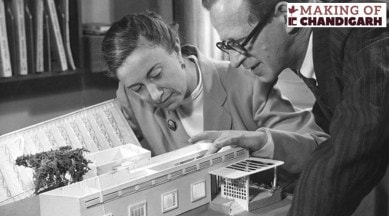Making of Chandigarh: Jane Drew’s Chandigarh and social housing
Jane Drew played a major role in the internal planning of the sectors in Chandigarh.

By Tamanna Pandita
During the dawn of Indian Independence when there was mayhem in the country, a need for a new capital in Punjab arose after the loss of Lahore to Pakistan. Finally, four architects namely Le Corbusier, Pierre Jeanneret, Jane Drew and Maxwell Fry were assigned to design the new Punjab capital – ‘Chandigarh’. Jane Drew’s selection was mostly based on her active research on social housing and her experience of working in the tropical climates of Ghana. In Chandigarh, the architects had to decide how they were to work together. As Corbusier insisted on defining his role majorly to designing government centers (high court, the secretariat, the Assembly chambers etc), Jane Drew and others were to take charge of the designing of low-cost housing, health centers, hospitals, educational institutions, cultural buildings and markets. With time, Jane Drew also played a major role in the internal planning of the sectors in Chandigarh.
Creating the city’s neighbourhoods
During the time of conception, as a result of the partition, the major requirement of the city (and the country in general) was to build good quality and affordable housing, with expenditure kept in tune with a strict budget. After some research on housing typologies at Oxford, it was Jane Drew’s proposal that initiated the thought that a typical residential sector was to be designed with each housing typology cluster serving a specific socio-economic group. This was to be manifested through the varying sizes of houses and density. Location of these clusters with varying densities is observed to have a relation with their distance from the Capitol Complex. For instance, the largest cluster comprising of the villas with the lowest density (25 people per acre) is located close to the government buildings near Sector-1.
In the 1940s, Jane Drew used the Architects’ Yearbook as a platform and the first issue of 1945 included a discussion by Jane Drew on social housing. Her sketches showed clustered housing with arranged terraces; it had a remarkable similarity with what she later proposed in Chandigarh which had a garden-suburb-modernist blend. There is also an application of what Patrick Geddes called Conservative Surgery in Sector-22 (the crooked road that Fry and Drew integrated into the plan of sectors). Jane Drew took a more anthropological approach to design; she sought an architecture that was homely and effective. She kept in mind the end-user of the city in the hope to formulate useful data and to have a more user-oriented approach.
Sector 22: The first sector
It is the government houses that give Chandigarh its distinct character. In total thirteen types of housing were finalized based on the monthly income of a government employee (from a peon to a minister’s house). Chandigarh has six distinct seasons with varying temperature ranges but the harsh sun of the summer was the major problem to be tackled with. Therefore, the main goal while designing the dwelling units was to protect from the sun and from the dust-laden winds (‘loo’) of the summer season. Jane Drew opted for larger spaces, greater volume and shading. Orienting the dwellings towards southwest was avoided and few and smaller windows were adopted on exposed facades. Brick was used extensively as it was the cheapest material available. Wood shutters were preferred over glass windows because wood was a cheaper material at that time and skilled Panjabi carpenters were easily available. Effort was made to keep the main rooms in the north or northeast direction. Sleeping places in the open were also provided; having a flat roof in houses was found useful.
According to Jane Drew, ‘The Sector 22 was a kind of a ‘model settlement’. It was to eventually house around 20,000 people and was to function as a town on its own. The sector design featured four entrance points and all houses have connectivity to both the interior road and the exterior fast motor road. All other amenities are planned inside the sector. Each sector has a series of planned open spaces that contain schools, clinics and other public and community buildings, while the edges of sectors have larger commercial centers and hotels ‘protecting’ the internal dwellings. The aim was to create a peaceful village like environment. The living conditions of many were greatly improved and it did set a precedent for the minimum standard of housing in India. Every house had waterborne sewage and a supply of pure drinking water and electricity.’
Jane Drew designed the ‘Type 13 peon housing’ for which the low-cost techniques were tested through building replicas at the present day Le Corbusier Centre site. The 13 D type houses are modest white dwellings consisting of three main rooms, a shower room and a toilet area. It was designed as a low cost housing unit and budget constraints were met by design solutions like adoption of a wooden batten and brick roof, omitting a roof over the toilet area placed on the outside and giving multipurpose areas such as the external space adjacent to the kitchen that could be used for cooking and laundry during hot and dry weather.
Apart from her neighborhood experiments, Jane Drew built various public buildings through which she contributed to the creation of the architectural vocabulary of Chandigarh owing to her innovative, low cost, climate responsive design solutions.
The author Tamanna Pandita is a student of Forth Year who has been mentored by Ar. Shilpa Sood, Assistant Professor in Chandigarh College of Architecture. The article is edited by Ar. Saumya Sharma, Assistant Professor in Chandigarh College of Architecture. This article is a part of the series of fortnightly articles by students and faculty of CCA on the Making of Chandigarh for the LCPJ forum.